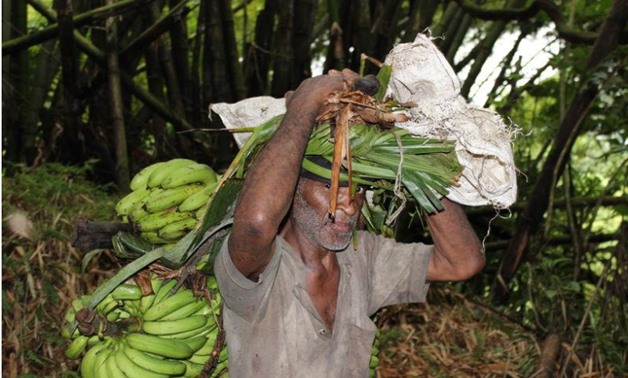
A man harvests wild bananas in the highland jungle on the edge of the Blue Mountains, historically maroon land in Jamaica. November 15, 2017- Reuters
MOORE TOWN, Jamaica– 21 December 2017: A Jamaican pledge to protect a mountainous jungle region from mining is a long-sought victory by an unlikely alliance of greens and the descendants of runaway slaves who claim the land.
At the cost of billions of dollars in potential earnings, Prime Minister Andrew Holness last month set aside the Cockpit Country as a “national asset” too valuable to exploit.
The decision has its detractors but plenty of beneficiaries too - be it future generations of Jamaicans or the current crop of parrots, butterflies, ferns and frogs that call Cockpit home.
Holness announced the creation of the 74,726-hectare Cockpit Country Protected Area last month, ruling out mining even though prospectors had already received licenses to look for bauxite.“This area is too valuable,” he said, elevating its status as a national asset over its potential monetary worth.
“While we will forgo the extraction of millions of tonnes of high grade bauxite and limestone with potential earnings of billions of United States dollars, we cannot put a price tag on the loss to our water resources and biodiversity.”
The decision won Holness plaudits from environmentalists.Jamaica Environmental Trust Executive Director Diana McCaulay said she was “certainly more optimistic” after more than a decade of campaigning to protect the zone.
McCaulay cited valuable aquifers and unique biodiversity, including rare species of parrots, butterflies, frogs, snails, and ferns, as reasons to protect the remote area.An impenetrable jungle in western Jamaica, the region is inhospitable to outsiders and also has a rich cultural history.
The land is claimed by the Accompong Town or Leeward Maroons, who are descendants of runaway slaves who fought the British to a bloody stalemate in a 90-year-war.Maroons were Africans who escaped slavery and mixed with indigenous populations to form independent settlements.
Separate maroon communities in the mountains of western and eastern Jamaica signed peace treaties with the British in 1739 that granted them permanent freedom from slavery and awarded them land autonomous from the colonial government in Jamaica.
They maintain an independent streak to this day - and say it was never for Holness to set aside land they consider their own.
“What the prime minister should have told the world is that the Cockpit Country is separate from Jamaica by our treaty rights,” Accompong Town Deputy Colonel Melvin Currie told the Thomson Reuters Foundation, using his honorific title as bequeathed to his ancestors by the British.
“The treaty says that we should live forever and hereafter in a total state of freedom.” Currie disputes how the British drew up the boundaries of the Cockpit Country and how much land is therefore theirs.McCaulay calls it “a complex legal issue” and that what should have been about 15,000 hectares was reduced to 1,500 hectares in the final document drawn up by the British.
The successful campaign to protect jungle in western Jamaica comes on the heels of international recognition for the natural and cultural heritage of eastern Jamaica.In 2015, the Blue and John Crow Mountains National Park became Jamaica’s first UNESCO World Heritage Site.
A biodiversity hotspot rich in natural attributes, the region was also singled out for its secret trails, archaeological remains, look-outs, hiding places and other features key to maroon culture.According to Susan Otokoun, executive director of the Jamaica Conservation and Development Trust, a charity which manages the national park, ecotourism destination is now its future.
“We see tourism as an opportunity for income generation,” she told the Thomson Reuters Foundation. “That was one of the ideas behind both the park and the heritage site – to create sustainable livelihoods.”
Moore Town, one of the oldest Windward or eastern maroon villages, sits on the lush edge of both the park and the World Heritage Site. It is a three-hour drive from the capital Kingston, the last on windy dirty roads into the mountains.
Colonel Wallace Sterling, leader of the 8,000 maroon descendants here, hopes tourism helps his village, with young people more likely to chase big-city opportunities than stay put.
“We want to see development in harmony with nature and encourage young people to stay, which is not the situation now,” Otoukon said. “Culture and natural heritage are ways you can stimulate economic growth.”
Above all, given the recent experience of his fellow maroons in Acompong Town with the Cockpit Country, Sterling believes the land must stay protected from resource exploitation.
“It is better to stay as it is and we remain poor, healthy, and happy than you giving us a few pennies and telling us that we’re better off,” he told Thomson Reuters Foundation on his front porch, peeling papaya picked from his yard. “The mining company is going to get most of the money.”
While environmentalists are rejoicing over the Cockpit Country Protected Area, they recognize their work is not done.
“We still have to hold the prime minister to his word to make sure he does what he said he’s going to do,” McCaulay said.Otoukon echoed those concerns.“The announcement leaves me feeling a bit positive but my concern is still the level of active management of these protected areas,” she said.
“Bauxite is not the economic future of the country,” she said. “It’s an unequal sacrifice. People who live in these areas are asked to give up their homes, livelihoods, and communities.”


Comments
Leave a Comment